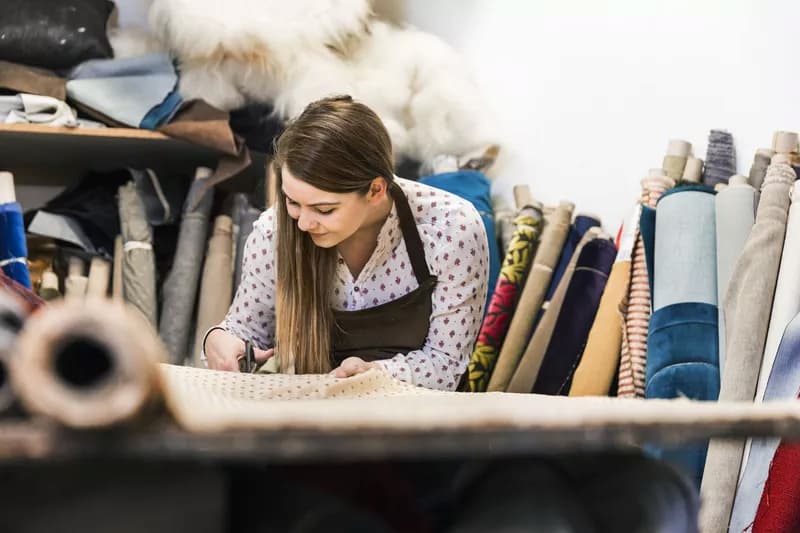Fashion
How Textiles Influence Your Mood and Atmosphere?

The art of designing pleasant indoor places blends creativity and functionality to improve both beauty and usefulness. Textiles, among the several elements employed in this artistic procedure, play an important role in determining the tone and mood of a place. These materials, with their suppleness and vibrant patterns and colours, can convert ordinary environments into remarkable ones. We will look at the important role of textiles in interior design along with how they may propel spaces to new levels.
Designers can add dimension and personality to any space by cleverly combining textures and colours. A velvety velvet sofa, a cosy woollen rug, or vivid patterned drapes can quickly bring life to an ordinarily dull room. It’s a better practice to first check the credit reports of companies that offer textiles for your house and a good example of a company that offers textiles is T & A Textile’s company, you should check the T & A textiles and hosiery limited credit check report, to see if they’re a good company or not.
Functional Textiles For Comfort And Practicality
Fabrics serve both aesthetic and functional reasons in design. Sofas and chairs upholstered in soft, sturdy fabrics provide both convenience and durability, rendering a place more appealing and usable. Furthermore, fabrics such as blackout curtains offer light control and confidentiality, and thermal curtains can manage interior temperatures, rendering a space more energy-efficient.
Playing With Patterns And Prints
Patterns & prints in materials offer limitless creative options. These patterns, which range from traditional stripes and geometric forms to elaborate floral motifs, may be carefully used to establish a focal point or give movement to a space. Bold patterns in decorative cushions, area rugs, and possibly wallpaper can add flair and character to an interior room.
Versatility In Application
Fabrics may be used in designs in a variety of ways, providing flexibility and customisation. Upholstery serves as one of the most prevalent uses. Upholstery, whether in a velvety fabric for a cosy armchair or a sleek leather overlay for a modern couch, lends refinement & warmth to furniture.
Curtains and draperies are another common way to incorporate fabrics into design. Sheer, lightweight textiles may produce an airy & otherworldly atmosphere, but heavy, luxurious curtains may lend a sense of grandeur and elegance to a space. Area rugs and carpets are multifunctional fabric components which define spaces, provide warmth underfoot, and reduce noise. These also act as decorative pieces, connecting diverse aspects.
Balancing Textiles And Other Elements
Establishing an aesthetically pleasing indoor space necessitates a careful balancing of various aspects, and textiles play an important role in this process. Whenever choosing materials, it is critical to take into account the room’s current aspects, such as furniture, flooring, and wall colours. A consistent colour palette and a variety of textures can result in a visually pleasing and well-organized space.
Sustainable Textiles For Environmentally Friendly Design
As environmental awareness increases, likewise, the need for sustainable, eco-friendly design solutions also increases. Introducing sustainable fabrics into design encourages responsible consumption and lends a particular beauty to a space while also benefiting the earth.
Influence On Emotional Impact
They have a significant impact on the psychological effect of interior spaces, in addition to their visual attractiveness and usefulness. Soft, soft textiles can provide a feeling of warmth and cosiness, making a room appear to be an inviting embrace. Sleek and smooth resources, on the other hand, may produce an up-to-date and professional atmosphere, which appeals to those who appreciate minimalism design.
Fabric selection can have a significant effect on the overall mood in spaces designed for unwinding, such as bedrooms and living rooms. Calming colours, mixed with soft, sumptuous textures, can create a feeling of tranquillity and help people relax after a hard day. In contrast, vivid and bold fabrics can provide vitality and enthusiasm to rooms such as playrooms & entertainment areas.
Seasonal Transformations
One of the most amazing characteristics of materials in interior spaces is their capacity to change with the seasons. Changing materials such as throw pillows, area rugs, and window treatments enable homeowners to customise their living areas for each season. And, while you’re enjoying the beautiful summer weather, look for an appropriate storage container to keep all of your hefty décor safe and sound. During the colder months, thick and warm fabrics like wool, faux fur, & velvet can be used to create a cosy and welcoming ambience. Lightweight and breathable fabrics, such as cotton and linen, are perfect for summer since they keep you cool and refreshed.
Final Words
Textiles serve an indisputable role in interior design, contributing to both aesthetically pleasing and usefulness. As you begin your design journey, continue to explore materials’ tremendous possibilities and how they’re able to easily convert any home into a refuge of beauty and comfort. Whether it’s a sumptuous sofa upholstered in velvety velvet or a sustainable area rug which pulls the room together, fabrics are going to stay a timeless and essential component of the ever-changing world of indoor design.
-
Blog1 year ago
MyCSULB: Login to CSULB Student and Employee Portal – MyCSULB 2023
-
Android App3 years ago
Cqatest App What is It
-
Android1 year ago
What Is content://com.android.browser.home/ All About in 2023? Set Up content com android browser home
-
Software2 years ago
A Guide For Better Cybersecurity & Data Protection For Your Devices
-
Latest News2 years ago
Soap2day Similar Sites And Alternatives To Watch Free Movies
-
Android2 years ago
What is OMACP And How To Remove It? Easy Guide OMACP 2022
-
Android3 years ago
What is org.codeaurora.snapcam?
-
Business2 years ago
Know Your Business (KYB) Process – Critical Component For Partnerships





















